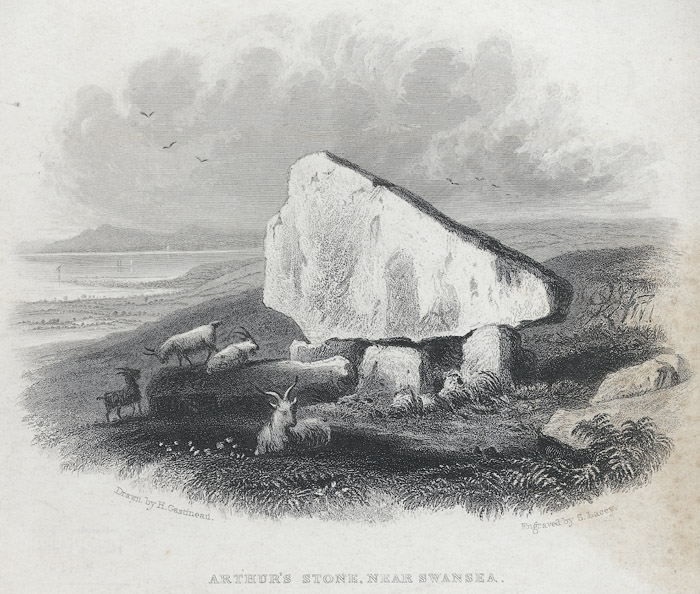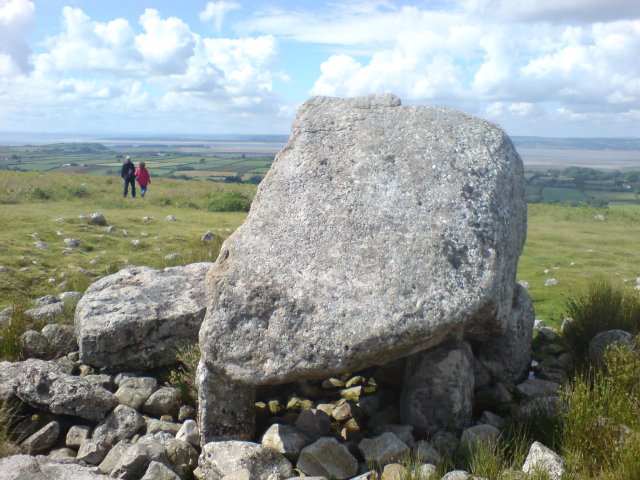Cefn Bryn on:
[Wikipedia]
[Google]
[Amazon]
 Cefn Bryn is an ancient ridge in
Cefn Bryn is an ancient ridge in
is the second highest point in the peninsula, offering panoramic views of the surrounding country and seas. The swathes of grassland around the ridge are known as ''Cefn Bryn Common''. Along the ridge of the hill, banked by grassy common on both sides is the road from Cilibion to

 Just north of the ridge summit of Cefn Bryn, there is a
Just north of the ridge summit of Cefn Bryn, there is a
 There is a small fresh water pool called Broad Pool at the foot of the eastern approach to the ridge. This pool is known to have existed since 1645, and has dried out and been re-excavated twice. Today it is a protected nature reserve. It lies in a shallow basin on the limestone plateau beneath Cefn Bryn, and consists of an
There is a small fresh water pool called Broad Pool at the foot of the eastern approach to the ridge. This pool is known to have existed since 1645, and has dried out and been re-excavated twice. Today it is a protected nature reserve. It lies in a shallow basin on the limestone plateau beneath Cefn Bryn, and consists of an Cefn Bryn factsheet from CCW
/ref>
Explore Gower: Cefn Bryn
{{European megaliths 4th-millennium BC architecture Archaeological sites in Swansea Bronze Age Wales Buildings and structures in Swansea Geology of Wales Megalithic monuments in Wales Prehistoric sites in Swansea Gower Peninsula Mountains and hills of Swansea Sites of Special Scientific Interest in West Glamorgan Stone Age Britain Stone Age sites in Wales Ridges of Wales Monuments and memorials in Swansea
 Cefn Bryn is an ancient ridge in
Cefn Bryn is an ancient ridge in Britain
Britain most often refers to:
* The United Kingdom, a sovereign state in Europe comprising the island of Great Britain, the north-eastern part of the island of Ireland and many smaller islands
* Great Britain, the largest island in the United King ...
. It is a 5-mile-long Old Red Sandstone
The Old Red Sandstone is an assemblage of rocks in the North Atlantic region largely of Devonian age. It extends in the east across Great Britain, Ireland and Norway, and in the west along the northeastern seaboard of North America. It also exte ...
ridge in south Wales
Wales ( cy, Cymru ) is a country that is part of the United Kingdom. It is bordered by England to the east, the Irish Sea to the north and west, the Celtic Sea to the south west and the Bristol Channel to the south. It had a population in ...
, in the heart of the Gower Peninsula
Gower ( cy, Gŵyr) or the Gower Peninsula () in southwest Wales, projects towards the Bristol Channel. It is the most westerly part of the historic county of Glamorgan. In 1956, the majority of Gower became the first area in the United Kingdom ...
, in the City and County of Swansea. Local people colloquially refer to it as the "backbone of Gower", as it protrudes from surrounding limestone
Limestone ( calcium carbonate ) is a type of carbonate sedimentary rock which is the main source of the material lime. It is composed mostly of the minerals calcite and aragonite, which are different crystal forms of . Limestone forms whe ...
. The highest point on the ridge (188m/617 fis the second highest point in the peninsula, offering panoramic views of the surrounding country and seas. The swathes of grassland around the ridge are known as ''Cefn Bryn Common''. Along the ridge of the hill, banked by grassy common on both sides is the road from Cilibion to
Reynoldston
Reynoldston is a rural village and a community in the City and County of Swansea, Wales, which had a population of 439 in 2011. The community has its own elected community council. The village is located deep in the heart of the Gower Peninsula.
...
. The road was previously known as the Old Coal Road and Red Road. Wandering sheep, wild ponies and cows can be seen along the road. Large swells and dips can be encountered along the route, formed by swallets and sinkhole
A sinkhole is a depression or hole in the ground caused by some form of collapse of the surface layer. The term is sometimes used to refer to doline, enclosed depressions that are locally also known as ''vrtače'' and shakeholes, and to openi ...
s in the surrounding limestone
Limestone ( calcium carbonate ) is a type of carbonate sedimentary rock which is the main source of the material lime. It is composed mostly of the minerals calcite and aragonite, which are different crystal forms of . Limestone forms whe ...
. The highest point of the road intersects with the ridge summit.
Arthur's Stone

 Just north of the ridge summit of Cefn Bryn, there is a
Just north of the ridge summit of Cefn Bryn, there is a neolithic
The Neolithic period, or New Stone Age, is an Old World archaeological period and the final division of the Stone Age. It saw the Neolithic Revolution, a wide-ranging set of developments that appear to have arisen independently in several p ...
burial ground, known as "Arthur's Stone" (). Its name comes from a legend that the ancient British King Arthur threw a large stone from Llanelli
Llanelli (" St Elli's Parish"; ) is a market town and the largest community in Carmarthenshire and the preserved county of Dyfed, Wales. It is located on the Loughor estuary north-west of Swansea and south-east of the county town, Carmarth ...
which landed on this spot.
It is believed that during the Bronze Age
The Bronze Age is a historic period, lasting approximately from 3300 BC to 1200 BC, characterized by the use of bronze, the presence of writing in some areas, and other early features of urban civilization. The Bronze Age is the second prin ...
Cefn Bryn was used extensively for ceremonies and rituals. Beneath the bracken on the hill over sixty cairns have been discovered. Most of these are likely to be no more than collections of stones cleared by local farmers; but just north-west of Arthur's Stone three prominent cairns have been excavated that prove their ancient role - the largest being Great Cairn, a circular heap of stones above a central grave.
Broad Pool
 There is a small fresh water pool called Broad Pool at the foot of the eastern approach to the ridge. This pool is known to have existed since 1645, and has dried out and been re-excavated twice. Today it is a protected nature reserve. It lies in a shallow basin on the limestone plateau beneath Cefn Bryn, and consists of an
There is a small fresh water pool called Broad Pool at the foot of the eastern approach to the ridge. This pool is known to have existed since 1645, and has dried out and been re-excavated twice. Today it is a protected nature reserve. It lies in a shallow basin on the limestone plateau beneath Cefn Bryn, and consists of an acidic
In computer science, ACID ( atomicity, consistency, isolation, durability) is a set of properties of database transactions intended to guarantee data validity despite errors, power failures, and other mishaps. In the context of databases, a ...
pond
A pond is an area filled with water, either natural or artificial, that is smaller than a lake. Defining them to be less than in area, less than deep, and with less than 30% emergent vegetation helps in distinguishing their ecology from ...
, heath
A heath () is a shrubland habitat found mainly on free-draining infertile, acidic soils and characterised by open, low-growing woody vegetation. Moorland is generally related to high-ground heaths with—especially in Great Britain—a cooler a ...
and bog, which is important for aquatic plants, amphibians, dragonflies
A dragonfly is a flying insect belonging to the infraorder Anisoptera below the order Odonata. About 3,000 extant species of true dragonfly are known. Most are tropical, with fewer species in temperate regions. Loss of wetland habitat threa ...
(including Southern Damselfly
''Coenagrion mercuriale'', the southern damselfly, is a species of damselfly in the family Coenagrionidae. It is found in Algeria, Austria, Belgium, France, Germany, Italy, Liechtenstein, Luxembourg, Morocco, the Netherlands, Portugal, Romania, S ...
) and wetland
A wetland is a distinct ecosystem that is flooded or saturated by water, either permanently (for years or decades) or seasonally (for weeks or months). Flooding results in oxygen-free (anoxic) processes prevailing, especially in the soils. The p ...
bird
Birds are a group of warm-blooded vertebrates constituting the class Aves (), characterised by feathers, toothless beaked jaws, the laying of hard-shelled eggs, a high metabolic rate, a four-chambered heart, and a strong yet lightweig ...
s./ref>
In art
A landscape painting of Cefn Bryn from Pennard castle by theNeo-impressionist
Neo-Impressionism is a term coined by French art critic Félix Fénéon in 1886 to describe an art movement founded by Georges Seurat. Seurat's most renowned masterpiece, '' A Sunday Afternoon on the Island of La Grande Jatte'', marked the beginn ...
painter Lucien Pissarro
Lucien Pissarro (20 February 1863 – 10 July 1944) was a landscape painter, printmaker, wood engraver and designer and printer of fine books. His landscape paintings employ techniques of Impressionism and Neo-Impressionism, but he also exhi ...
may be seen in the Glynn Vivian Art Gallery
The Glynn Vivian Art Gallery is the public art gallery of the City and County of Swansea, in Wales, United Kingdom. The gallery is situated in Alexandra Road, near Swansea railway station, opposite the old Swansea Central Library.
History
The ...
, Swansea.
References
External links
Explore Gower: Cefn Bryn
{{European megaliths 4th-millennium BC architecture Archaeological sites in Swansea Bronze Age Wales Buildings and structures in Swansea Geology of Wales Megalithic monuments in Wales Prehistoric sites in Swansea Gower Peninsula Mountains and hills of Swansea Sites of Special Scientific Interest in West Glamorgan Stone Age Britain Stone Age sites in Wales Ridges of Wales Monuments and memorials in Swansea